| |
|
|
| |
|
|
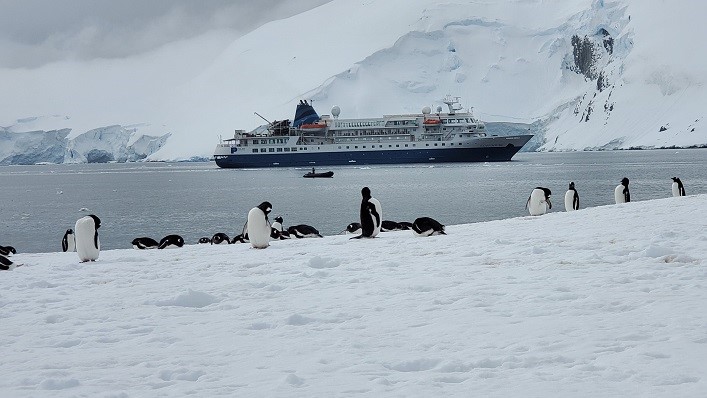 |
|
This was our ship, the SeaVenture, run by a company called Polar Lattitudes. Max capacity is 139 passengers but we only had 115. There were a few open cabins. It had a crew of about 70 and about 18 guides. We had a really nice cabin with lots of storage space, mini fridge and all that. Plus a big window on the starboard side. It was built in 1990 but was refurbished last year. At 111 meters (364 feet), it is a small ship but In rough weather they have stabilizers they can deploy to tamp the motion. Very few people got seasick on our voyage. To learn more about this ship, go here.
If you go to Antarctica, it is good to be on a ship with about 100 passengers as rules only allow 100 people at a time to disembark on land with wildlife. On our ship they always let the entire group of passengers (and many of the guides) go ashore at once.
If you are considering a trip to Antarctica, contact us first! We have some invaluable tips and information. |
sm2.jpg) |
|
The guides were very good and had some solid credentials. Some passengers signed up for kayaking trips but we stuck to the zodiac rides and hikes on the islands. Many of these "expedition" team members have other jobs such as fishing ship captain in British Columbia, owner of a guiding outfit in Canada, and a day trip whale watching outfit also in Canada. The group leader, Nate Small does both Antarctica and Arctic trips and over the last 10 years has logged over 70 trips in both hemispheres. He knows the areas well and was making some excellent decisions based on weather and wildlife. Included in this team were marine biologists, ornithologists, historians, one ship photographer, and kayak guides. |
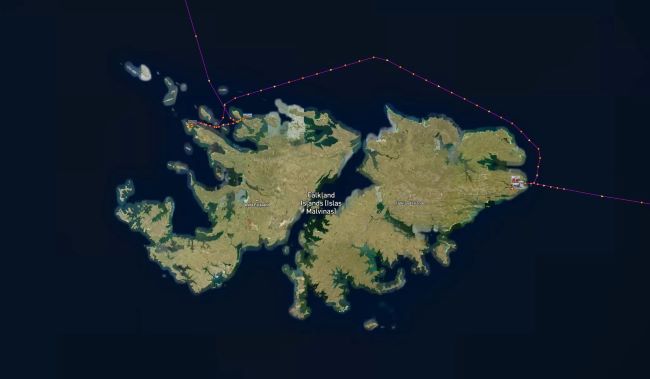 |
|
We departed from a city called Puerto Madryn in Argentina on November 2nd. Puerto Madryn is a 16 hour bus ride or a two hour flight south of Buenos Aires. We took the plane!
We were then at sea for two days on the journey to the Falkland Islands. There are two islands, West and East. We had two landings on the West side and one on the East. The West island was very interesting and we even noticed some surfable waves! On the east side we went to the main town, Stanley. |
sm.jpg) |
|
Here is a pic of the hike we did at Saunders Island (on the West side). There were penguins on the beach, albatross nesting, and some very small dolphins riding the waves. Further up (behind us) was a colony of the cutest Rock Hopper penguins. Instead of waddling like penguins, they hop from rock to rock. You will have to see the movie to appreciate this! |
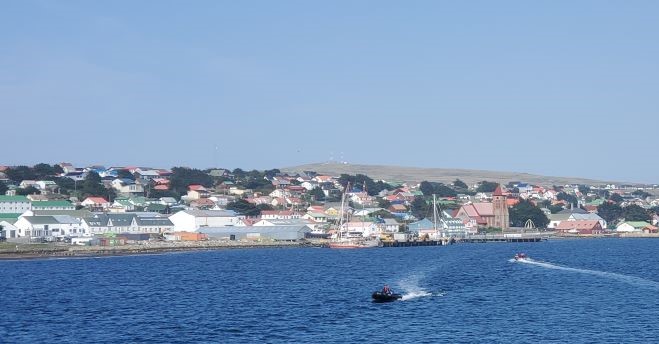 |
|
Stanley, the main and really only town in the Falklands, is a cute, fun place we explored for the day. Argentina is still upset over the Falkland war in 1982. It lasted about two months - in total, 907 people were killed in the conflict.
In Argentina they still claim ownership and the islands are called Islas Malvinas. Throughout Argentina you will see signs "Islas Malvinas son Argentinas" Yet, the population of the islands are decendents of the British and they choose British rule. |
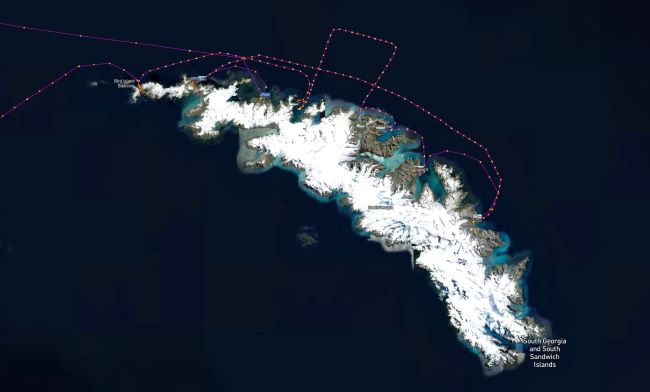 |
|
South Georgia was our second stop. This island is basically in the middle of nowhere and it took two days to get there from the Falklands. South Georgia is also a territory of Great Britian and was occupied by Argentina during the war. The East side of the island is the calm side where one finds a number of anchorages and safe harbors. As you can see, we spent a few days exploring South Georgia. Unfortunately, a big storm was brewing to the South of us so we forfeited a stop on the south end and hopped back North, heading on to Antarctica. Landings here included Salisbury Plain, Right Whale Bay, St. Andrews Bay, Grytviken, Stromness, Fortuna Bay and Eslehul.
|
sm.jpg) |
|
This place is known for its penguins! Here on the Salisbury Plain you will find about 250,000 king penguins. The little brown furry ones are the babies and they are constantly squacking for food. The sound and view here is incredible. Still pictures or even movies don't give it justice. If you ever plan on a trip to Antarctica, be sure to include a stop at South Georgia and hopefully the tour will include a hike at Salsbury Plain. |
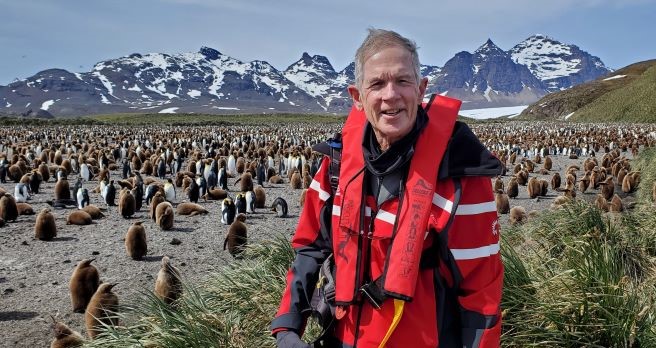 |
|
Penguins, penguins and more penguins. Weather in this area is unpredictable. Sunny blue sky one moment, then the wind comes up and the clouds roll in. Temperatures ranged from about 40 degrees up to about 65 - that was a hot day! It rained and even snowed on us during this trip. All in all, we were fortunate to have what would be considered good weather.
We did make some deviations because of storms. |
sm.jpg) |
|
These cute little guys are very curious! They had no fear of humans and would walk right up to us. Unfortunately, there is the likelyhood of avian flu being transmitted so we were under specific orders to maintain at least a 15 foot distance. We were constantly back pedaling as they approached. It must have been funny in the minds of these baby birds, these huge animals so afraid of us!
Penguin chicks are covered by thick, brown feathers until they start to molt at 10 to 12 months old. Their baby feathers are eventually replaced by sleek, black feathers on their backs, white feathers on their chests and orange feathers on their ears and throats. The waterproof adult feathers, and the blubber underneath, helps to keep them warm in the freezing ocean waters. These guys will stay out of the water until they mature and during this time, they rely on the parents to feed them.
Whenever we went ashore, we had to wear rubber boots. Just before we left the ship, we would stand in a tub of Virkon, a biocide for animal health. Then on our return back to the ship, we went through a decomination station. First they pressure washed the bottom of our boots. Then we went through a "boot car wash" with whirling brushes and finally stepped into the pan of Virkon. They are very serious about tracking foreign objects to the pristine lands. |
sm2.jpg) |
|
The main "town" on South Georgia is called Grytviken. It has an official population of 8 people. They work seasonally for the S. Georgia heritage trust, are military or customs officers. The town has a lot of history as it was a major whaling and whale processing center from 1904-1966. In the first year of operation, they killed and processed 195 whales. During its heydey, over 300 people worked at the processing center.
The whale population in the seas around the island was substantially reduced over the following sixty years until the station closed in December 1966, by which time the whale stocks were so low that their continued exploitation was unviable. Even now, the shore around Grytviken is littered with whale bones and the rusting remains of whale oil processing plants and abandoned whaling ships.
Cruise ships routinely visit this town for a day. The vibes here were sad and we were glad to get back on the ship. |
sm.jpg) |
|
Ernest Shackelton was buried here (Grytviken). You may recall that he attempted to cross the continent of Antarctica in 1914. Well, it was a heavy snow and ice year and their ship soon got stuck in the sea ice and eventually sunk. Stuck on moving ice, Shackelton led his men to land at Elephant Island. Then he and a small crew of five set out in a very small boat to S. Georgia. It was an 800 mile journey and took about three weeks. Crazy! Historians regard the voyage of the crew in a 22.5-foot (6.9 m) boat through the " Furious Fifties " as one of the greatest small-boat journeys ever completed. From South Georgia, Shackelton went back in a ship and rescued his remaining crew - not a life was lost! If you are so inclined, read the book Endurance by Alfred Lansing - it's a page turner!
At the grave site, it is a tradition to read a short speech and make a toast to Shackelton. They gave us a small cup of whiskey, we took a sip (a very small sip) then as per the tradition, poured the rest on the grave site. Shackelton would have been pretty happy! |
| |
|
|
|
|
There is a post office in the town. Barb sent her mom a post card. Who know how long it will take to arrive!
|
sm.jpg) |
|
It would be two full days of cruising to get from South Georgia to Antarctica. At left, we spot our first iceberg, November 13th at 6 pm, about halfway between South Georgia and Antarctica (-56.70706, -45.26668) It was Springtime (equal to May 13th up North) and at 57 degrees south lattitude, we are equivalent to somewhere in Southern Alaska (57 north). There was very little darkness. In fact, with cloud cover and normal sleeping schedules, we never once saw the stars out in the night sky. |
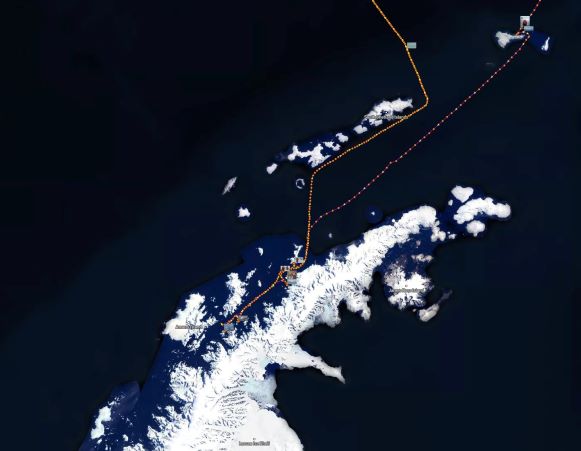 |
|
Antarctica! Our first stop was Elephant Island (in the upper right of the picture). It was here that Shackelton's men spent four plus months (April-August, 1913) hunkered down waiting for a rescue that they weren't sure was even going to happen. Other stops on the Antarctic peninsula included Mikkelson Harbor, Cierva Cove, Cuverville Island and Wilhelmina Bay. We were originally scheduled to spend one more day in Antarctica but a really huge storm was brewing and we used the leeward side of the South Shetland Islands as a partial block (see the map left and the weather map below) then, we made a quick left turn and beat feet for Ushuaia on the tip of South America. Missed was a great island to visit called Deception Island. It is a volcanic crater and a super calm harbor. You can see it on the map as a tiny horseshoe, with the harbor opening at about 5 O'clock, near the south end of the Shetland islands.
Antarctica has penguins, but nothing like South Georgia. What you will see is stark scenery, rock cliffs, mountains, lots of snow and beautiful glaciers. The water is crazy blue and the air is as pure as it gets!
|
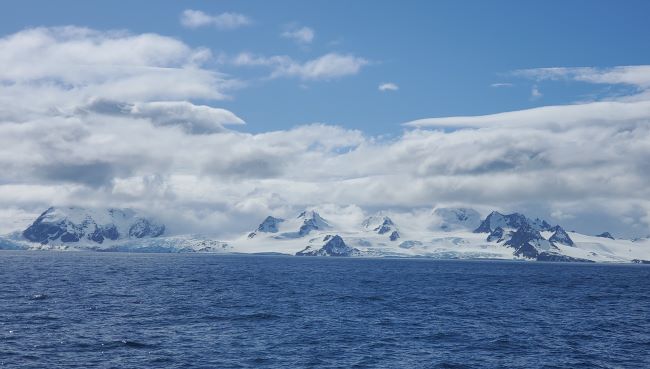 |
|
Elephant Island, one of the furtherest Northern places that is part of Antarctica. Can't imagine what it was like to spend four months here, hunting penguins and seals for food, trying to survive and yet, not know if Shackelton survived the 800 mile journey to S. Georgia to summons help.
Now days, you simply push the SOS button on your emergency locator beacon and help will arrive. Had they not reached Elephant Island, they would have been stuck on a moving mass of sea ice which would have been certain death as the ice broke up. |
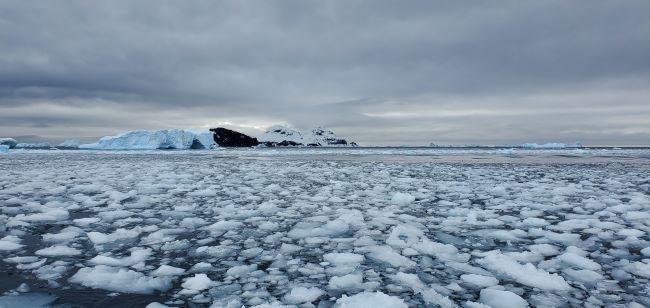 |
|
Sea Ice - the small stuff shown here is called "bergy bits", as in pieces of icebergs. After hiking around on land (or snow as it might be), we would cruise in the zodiacs and plow through the bergy bits. The scenery was wild. Deep blue clear water, you could see the underwater parts of the icebergs and the air was so clear and clean - experiences one doesn't find in Southern California. See a larger size of the very top image (or click on it for a bigger view) -Cuverville Island. Look at the water, look at the colors, see the penguins cruising along their "penguin highway". |
sm.jpg) |
|
Antarctic glacial ice, all we need is a gallon of tequila!
When you observe an iceberg, it typically looks white in color. It takes on that color because sunlight is scattered by the millions of air bubbles frozen into the ice itself. Sunlight can't penetrate very far into the iceberg before all of those bubbles scatter the light through all of its visible wavelengths, resulting in the white appearance to the human eye. However, icebergs can appear in shades of blue or even green, especially older icebergs, often composed of ice that has been under pressure for some time. The pressure removes any air bubbles in the ice that could reflect sunlight. As a result, the solid ice absorbs the red color of the visible light spectrum and greens and blues are reflected back to the human eye. When most of the air is removed, the ice looks clear. The ice we are holding is some very old ice!
Then, it snowed one evening and of course we had to build a snowman on the deck. The pool by the way was empty.
|
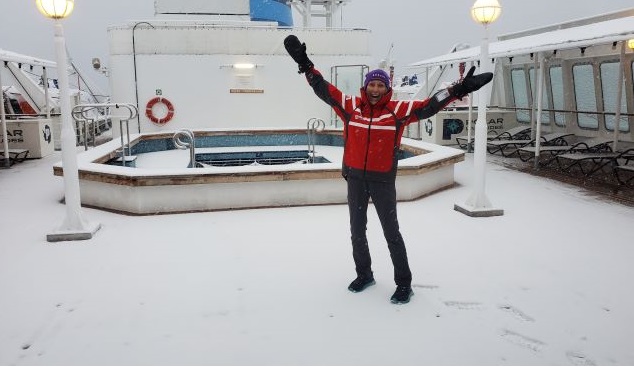 |
|
sm.jpg) |
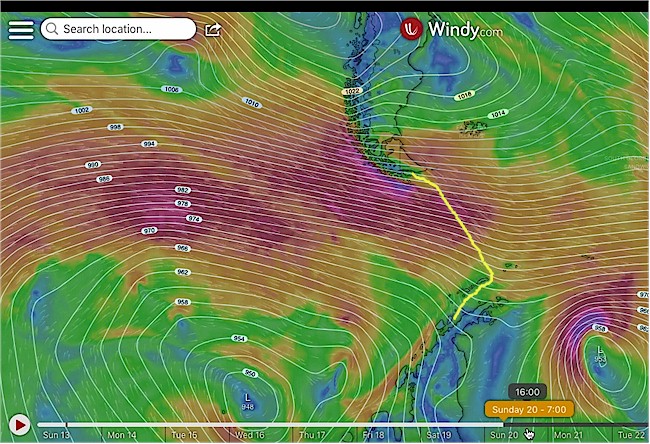 |
|
When you go to Antarctica, you never know what the weather will bring. November is the first part of the travel season and the weather can be more iffy then. We were told that we had a pretty good weather window for our three weeks aboard the Seaventure. The ship captain and group leader were constantly consulting with weather maps (windy.com is a great site!) and deciding exactly where to go when and how to best maximize this trip. They did a stellar job!
Yes, we lost a day due to weather but look at the map! All that purple stuff moved in just near the end of our crossing. We entered the calm waters of the Beagle channel on Nov. 20th at about 1:30 pm. It took us two days to cross the Drake passage, The big storm hit just before we pulled into the Beagle Channel, a calm area. It was the roughest part of the journey but there were some ships behind us that got hammered. |
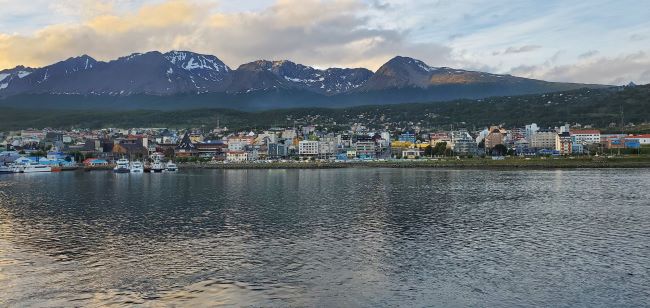 |
|
After spending the last two days crossing the Drake Passage (they either call it the "Drake Shake" or the "Drake Lake" - we had more of the "Drake vibration") we reached Ushuaia, Argentina, on the tip of South America. Jack was here in 1971 with a backpack and it was then a tiny village. We spent the night here in a wonderful hotel as part of the cruise program and flew out the next day to El Calafate, Argentina where we would shift into the hiking part of this trip.
See Part 1 (Iguazu Falls) and
Part 3 (Hiking in Patagonia) coming soon! |
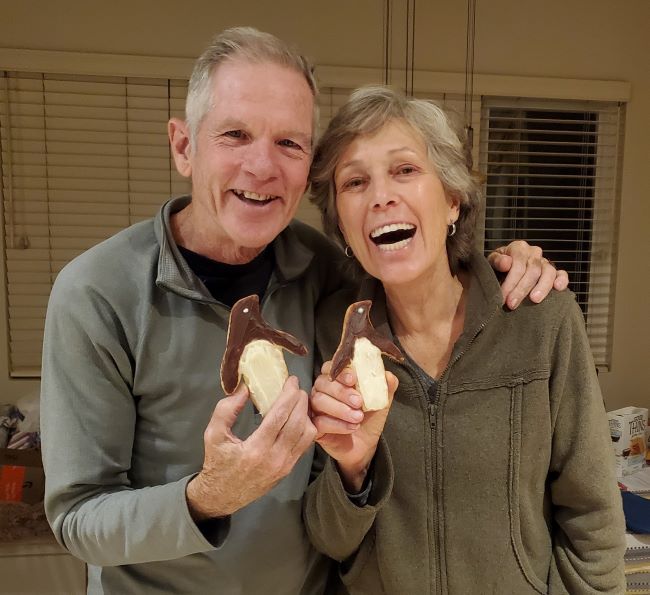 |
|
After returning home, our friends Eric and Lynn came over and suprised us with a batch of gluten-free penguin cookies! How cute! |
Videos for this trip
Iguazu Falls (Brazil side)
20 days on the SeaVenture
plus hiking in Patagonia
|
|
|
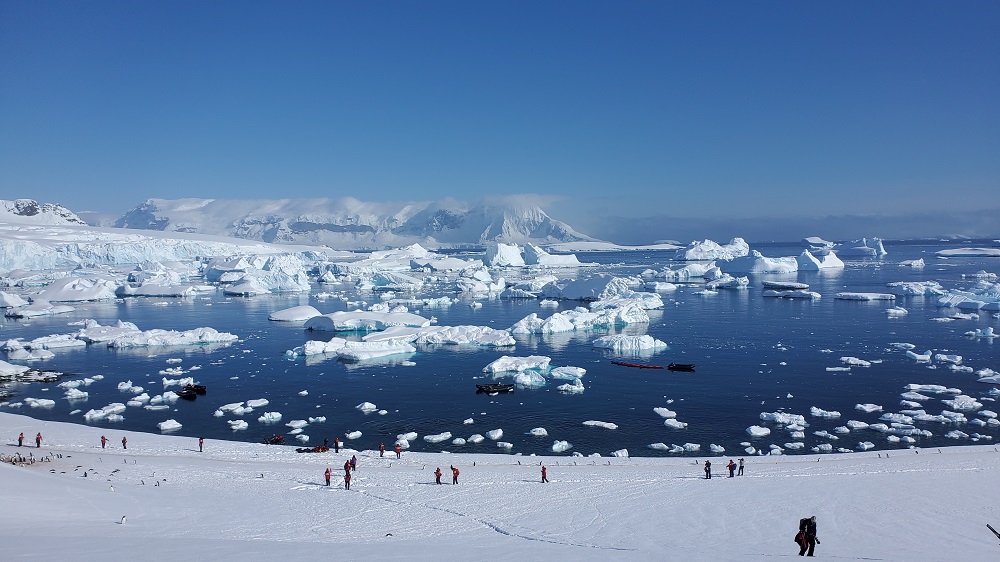

sm2.jpg)

sm.jpg)


sm.jpg)

sm.jpg)
sm2.jpg)
sm.jpg)
sm.jpg)
sm.jpg)



sm.jpg)

sm.jpg)


